As a pet parent, I’ve watched my own dog slow down over the years. It made me wonder—does my senior pup actually need different food than when she was younger?
The truth is, senior pets really do have unique nutritional needs that differ from adult dogs and cats. They need adjustments in protein quality, calorie content, and specific nutrients to support their aging bodies.
Yet there’s a huge gap between what we think our older pets need and what’s actually in those “senior” pet food bags on the shelf.
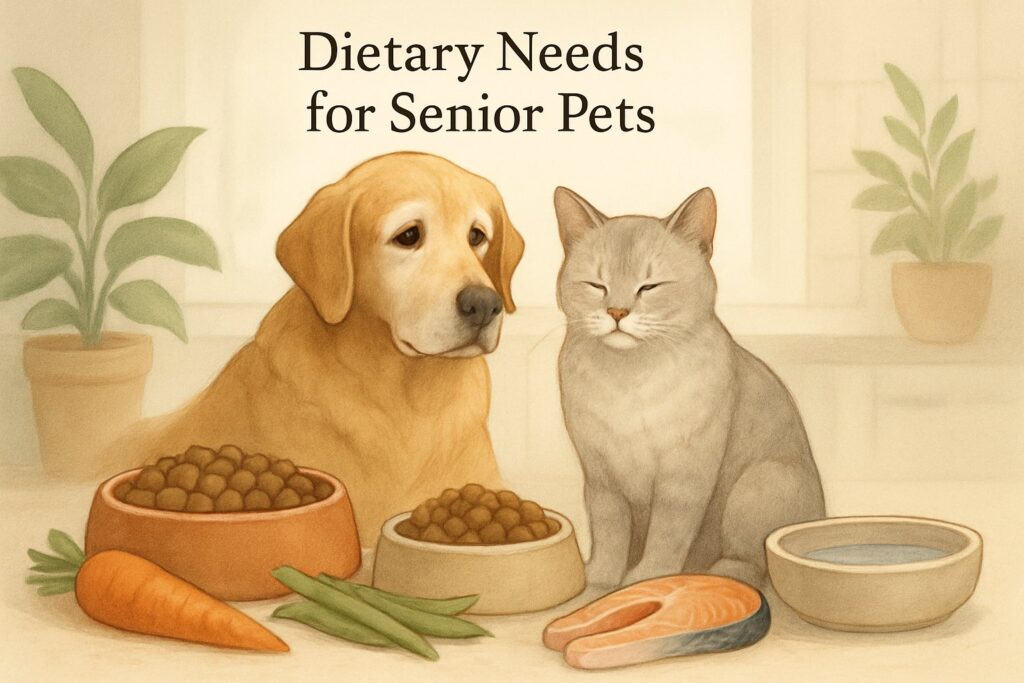
Table of Contents
Honestly? The pet food aisle can feel like a maze when you’re trying to figure out what’s best for your graying companion. Maybe your 8-year-old cat is slowing down, or your 10-year-old dog seems pickier about food lately.
These changes aren’t just in your head.
You’re about to learn what actually makes senior pet nutrition different and which nutrients matter most as pets age. I’ll walk you through the science behind senior pet diets and give you steps that make the transition easier for both of you.
Senior Pet Dietary Needs – Key Takeaways
- Senior pets need higher quality protein and specific nutrients to maintain muscle mass and support aging organs.
- Commercial senior diets vary widely in their nutritional content, so you need to assess what’s best for your individual pet.
- Regular veterinary monitoring and dietary tweaks become more important as pets’ nutritional requirements change more frequently with age.
Why Senior Pets Need a Diet Makeover
Let’s be real—your aging furry friend isn’t the same spunky pup or kitten they once were. As pets hit their golden years, their bodies go through changes that directly impact how they process food and absorb nutrients.
How Aging Changes Pet Nutrition
I’ve seen plenty of pet parents struggle with this: their senior dog can’t finish meals, or their older cat seems less interested in food. Aging affects nutrient utilization in ways that catch most owners off guard.
Metabolic Changes Hit Hard
Your pet’s metabolism naturally slows down with age. That same portion size that kept them healthy at age 3 might now pack on unwanted pounds at age 10.
Senior pets also experience changes in their digestive system. Their gut doesn’t absorb nutrients as efficiently as before.
Muscle Loss Becomes Real
Here’s the kicker—sarcopenia affects aging pets just like it does humans. I’m talking about the gradual loss of muscle mass that happens even if your pet’s weight stays the same.
Your senior pet might weigh the same but have less muscle and more fat. This shift changes everything about their nutritional needs.
Key Nutritional Shifts Include:
- Higher protein requirements to maintain muscle mass
- Different fat levels to support joint health
- Enhanced antioxidants for cognitive function
- Modified calorie needs based on activity levels
Recognizing the Signs of Nutritional Shift in Older Pets
You know that look your senior pet gives you when they’re just not feeling their best? Often, it’s their way of telling you their current diet isn’t cutting it anymore.
Physical Changes You Can’t Ignore
Pet parents often miss these early warning signs. Your once-energetic dog now struggles to climb stairs.
Your cat sleeps more and plays less.
These aren’t just “normal aging”—they’re often signs your pet needs a nutritional upgrade.
Appetite and Eating Pattern Changes
Ever watched your senior pet pick at their food instead of diving in? Changes in eating behavior signal shifting nutritional needs.
Some pets eat less because their sense of smell fades. Others develop pickier habits as their taste preferences change.
Watch for These Red Flags:
- Difficulty chewing or swallowing
- Weight loss or unexplained weight gain
- Dull, thinning coat
- Increased bathroom accidents
- Confusion or disorientation
Behavioral Shifts That Matter
Your senior pet’s personality changes often connect to nutrition. That grumpy morning mood? It might be low blood sugar from skipping out on overnight nutrition.
Increased anxiety or restlessness can mean your pet isn’t getting the brain-supporting nutrients they need. Cognitive changes in senior pets often respond to targeted nutritional tweaks.
Protein and Nutrient Priorities for Aging Pets
Your senior pet’s body works harder to maintain muscle mass and energy as they age. Protein quality becomes more critical than ever.
Strategic fat content and calorie management help keep aging pets healthy without adding unwanted weight.
High-Quality Protein: Keeping Muscles Strong
Let’s be honest—watching your once-spry dog struggle to jump on the couch stings. That muscle loss isn’t just aging; it’s often poor protein intake.
Senior dogs actually need more protein, not less, to fight muscle wasting. I see too many pet parents cutting protein thinking they’re helping.
Quality over quantity matters most:
- Look for named meats as first ingredients (chicken, salmon, beef)
- Avoid generic “meat meal” or “by-products”
- Pick easily digestible proteins like fish or lean poultry
Your aging pet’s digestive system gets pickier. High-quality animal proteins provide complete amino acid profiles that plant proteins can’t match.
Think of it like this: maintaining lean body mass in aging cats requires protein your pet can actually use. Cheap fillers just create expensive urine—seriously.
Red flags to avoid:
- Foods listing corn or wheat as top ingredients
- Generic “animal protein” without species identification
- Protein levels below 25% for senior dogs, 30% for cats
Fat Content and Calorie Control Strategies
Here’s the kicker—senior pets need fewer calories but better nutrition. It’s like threading a needle while your pet gives you those “where’s my food?” eyes.
Smart fat management starts with understanding your pet’s new reality:
- Slower metabolism means easier weight gain
- Joint issues make exercise harder
- Less muscle mass burns fewer calories naturally
I recommend targeting 8-12% fat content for most senior pets. Active seniors can handle a bit more, while couch potatoes need the lower end.
Calorie control that actually works:
- Measure food with a kitchen scale, not cups
- Count treats in daily calorie totals
- Switch to lower-calorie training rewards
Senior pet nutrition research shows that maintaining ideal body weight adds years to your pet’s life. Every extra pound puts four pounds of pressure on their joints.
The fat quality game-changer:
- Omega-3 fatty acids from fish oil reduce inflammation
- Avoid generic “animal fat”—look for specific sources
- Medium-chain triglycerides support brain health in aging pets
Special Dietary Needs: From Omega-3s to Fiber
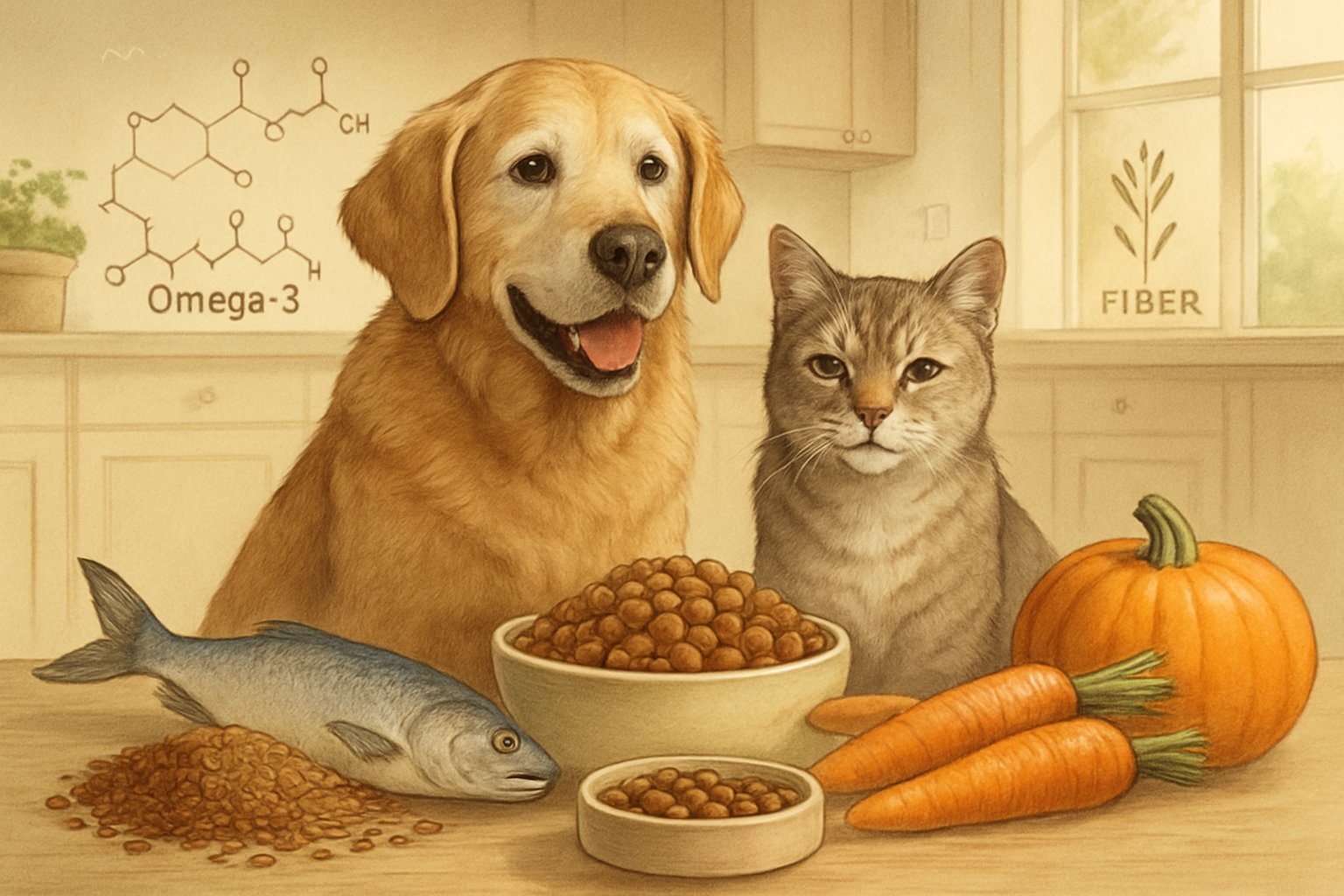
I’ve seen so many senior pets transform when their owners finally figure out these two game-changers. Omega-3 fatty acids become your aging pet’s secret weapon for sharp minds and mobile joints.
The right fiber and supplements lay the groundwork for healthy digestion and better nutrient absorption. Sometimes it really is that simple.
Omega-3 Fatty Acids for Brain and Joint Power
Let’s be real—watching your once-spry companion slow down, struggle with stiff joints, or seem “foggy” is just heartbreaking. I’ve seen this happen more times than I’d like, but here’s what can make a real difference: omega-3 fatty acids.
Your senior pet needs specific omega-3s—EPA and DHA—not just any random fish oil you find at the store. Research shows that EPA and DHA fed to senior companion animals can assist in slowing retinal degeneration and help with cognitive function.
Think of DHA as brain fuel for your pet. It keeps those neurons zipping along, helping with memory and alertness.
Meanwhile, EPA is like a natural anti-inflammatory, easing those creaky joints that make walks tougher than they used to be.
Key omega-3 benefits for senior pets:
- Brain health: Maintains cognitive function and alertness
- Joint mobility: Reduces inflammation and stiffness
- Eye health: Slows age-related vision decline
- Heart function: Supports cardiovascular wellness
I usually look for supplements with a 2:1 EPA to DHA ratio for the best joint and brain support. Your vet can help figure out the right dosage for your pet’s size and needs.
The Role of Fiber and Essential Supplements
Ever notice your senior pet’s digestion just isn’t what it used to be? That’s where fiber steps in—but not just any kind.
Studies show that prebiotic fibers can be supplemented to the diet of senior pets to support their changing nutritional needs. I’ve seen some pretty great improvements when owners add the right fiber blend.
Soluble fiber acts like a gentle broom, slowing digestion so your pet absorbs more nutrients. Insoluble fiber keeps things moving through the digestive tract.
Your senior pet also needs these essential supplements:
- Probiotics: Restore healthy gut bacteria that decline with age
- Digestive enzymes: Help break down food when natural production drops
- Antioxidants: Combat cellular damage from years of wear and tear
Here’s my favorite fiber trick: Start with 1 teaspoon of pumpkin puree per 10 pounds of body weight daily. Most pets love it, and it covers both fiber types.
Watch for signs your pet needs more digestive support—irregular poops, extra gas, or acting hungry even after eating. These usually mean it’s time to tweak their fiber or add a supplement.
Catering to Cats and Senior Dogs: Unique Challenges
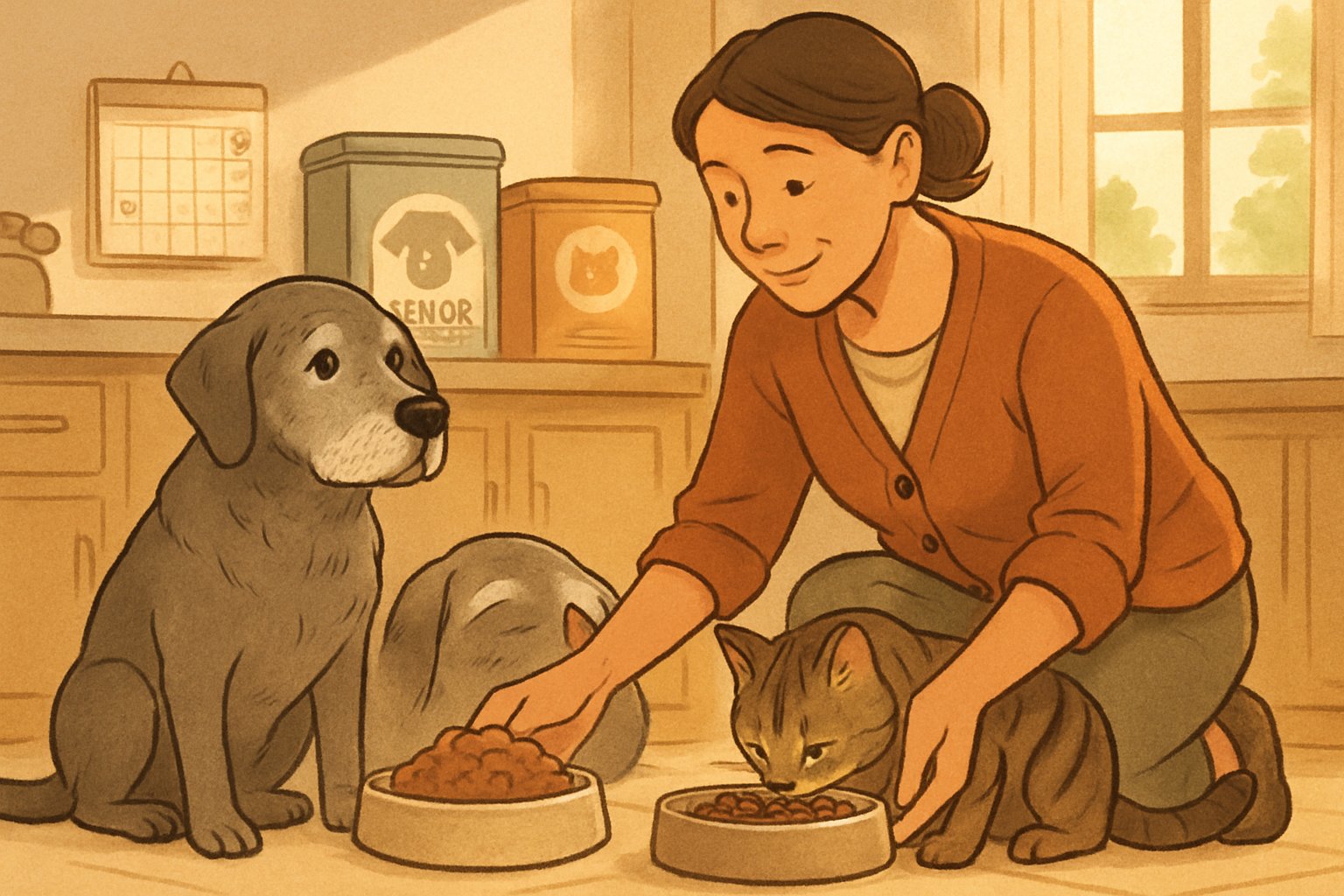
Senior dogs need fewer calories but more targeted nutrition, while aging cats face dental issues and appetite changes that call for totally different feeding approaches.
Nutritional Tweaks for Senior Dogs
I’ve noticed that senior dogs run into mobility problems that completely change how they eat. Lots of older pups develop arthritis or joint pain, making it tough to bend down to their bowls.
Elevated feeding stations can make a big difference. I usually raise bowls to chest height so my dog doesn’t have to strain.
Calorie reduction is critical as senior dogs slow down. Senior canine pet foods tend to have reduced energy content to match their new pace.
Here’s what I focus on for older dogs:
- Smaller, frequent meals instead of two huge ones
- Higher-quality protein to help keep muscle
- Joint-supporting supplements like glucosamine
- Softer textures for dental problems
Feeding little and often rather than in two meals helps with digestion and keeps bloating at bay. I usually suggest three or four smaller portions a day.
Managing weight gets tricky as senior dogs lose muscle but can still gain fat. I keep an eye on their body condition and adjust portions as their activity changes.
Adjustments for Senior Cats’ Health
Aging cats are a whole different story. I’ve found senior felines often get pickier—just when they need good nutrition most.
Dental problems hit older cats hard. Their tiny teeth can get painful, making eating tough.
Wet food is a must for senior cats. Softer food protects sore gums and gives a hydration boost their kidneys need.
I focus on these for senior cat nutrition:
- Increased protein to fight muscle loss
- Enhanced palatability—warming food or adding flavor helps
- Kidney-friendly formulas with less phosphorus
- Easy-to-digest ingredients for sensitive tummies
Mobility issues may create difficulty or pain when accessing food. I set up multiple feeding stations on different floors so my cats don’t have to deal with stairs.
Senior cats also go through cognitive changes that mess with eating habits. Some forget mealtimes, others get anxious about food. Sticking to a routine and keeping food available helps lower their stress.
Practical Steps: Building and Adjusting Senior Pet Meal Plans
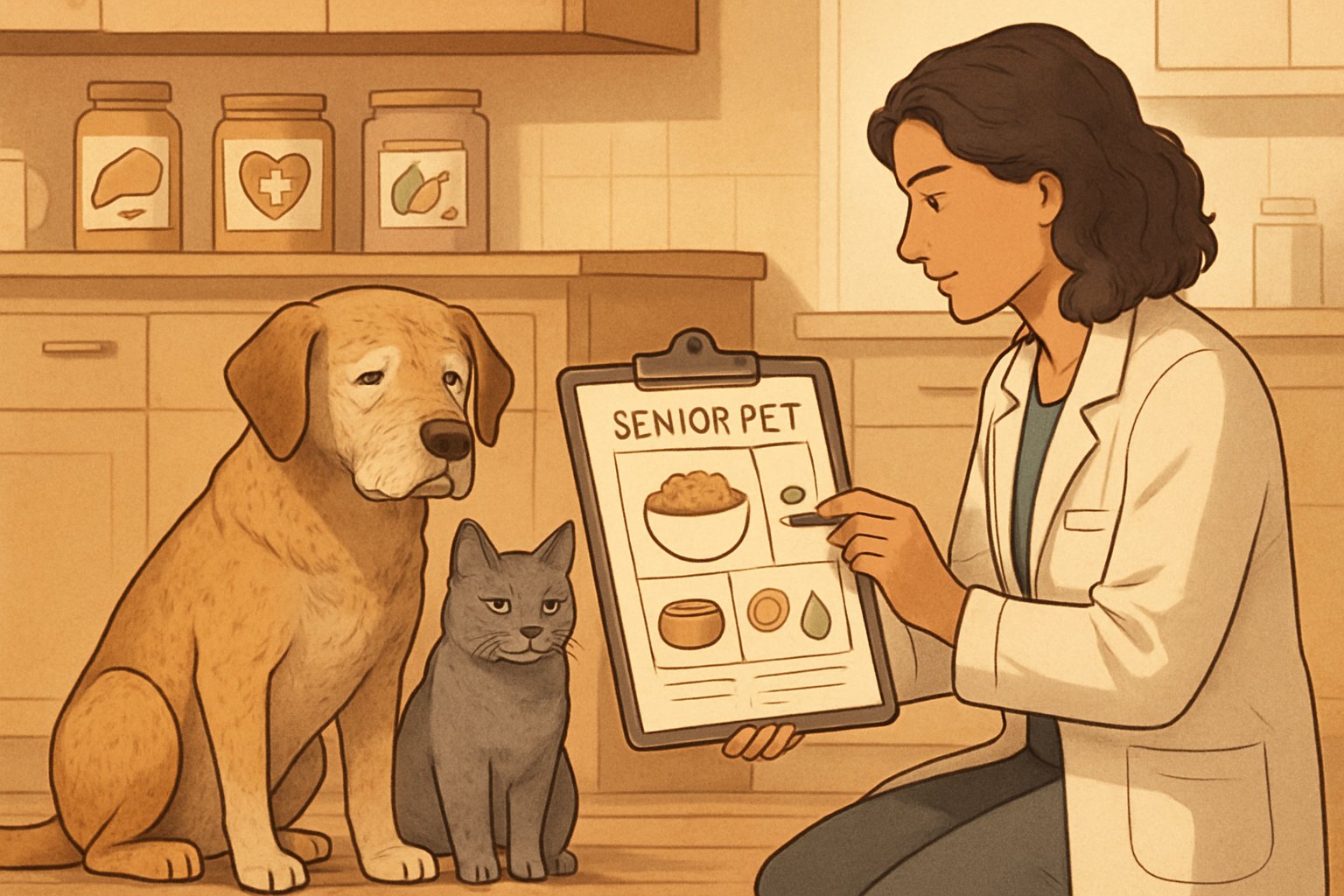
Building the right meal plan for my senior pet means nailing portion sizes and making changes that actually stick. I start small and watch how my furry friend reacts to each tweak.
Portion Sizes and Transition Tips
Honestly, I learned the hard way—senior pets need way less food than I thought. My 12-year-old lab started getting chubby because I kept feeding him like he was still a puppy on the run.
Senior pet nutrition requires frequent monitoring to keep up with their slowing metabolism. I usually cut portions by around 10-15% to start.
My go-to portion adjustment method:
- Week 1: Reduce current food by 10%
- Week 2: Watch weight and energy
- Week 3: Adjust up or down by 5%
When switching foods, I use the 7-day rule. Mix 25% new food with 75% old for days 1-2, then go half and half for days 3-4. By day 7, it’s all new food.
If I see loose stools or refusal to eat, I slow down the transition. It’s not worth the tummy upset.
Integrating Dietary Changes Into Daily Routines
The biggest mistake? Changing everything at once. My senior cat gave me the stink eye for days.
I get better results by keeping meal times and routines exactly the same. Same bowl, same spot—only the food changes.
What works in my house:
- Morning routine: New food goes in the regular bowl
- Treats: I swap out old treats gradually over a couple weeks
- Supplements: Mix into wet food first, then dry
Nutritional adjustments need to account for senior pets’ changing needs without throwing off their comfort zones.
I track everything for the first month—weight, energy, bathroom habits. It might sound nerdy, but it saves me headaches later.
My secret? One change at a time. New food this week, maybe adjust the feeding schedule next month.
Monitoring Progress: Vet Visits and Day-to-Day Observations
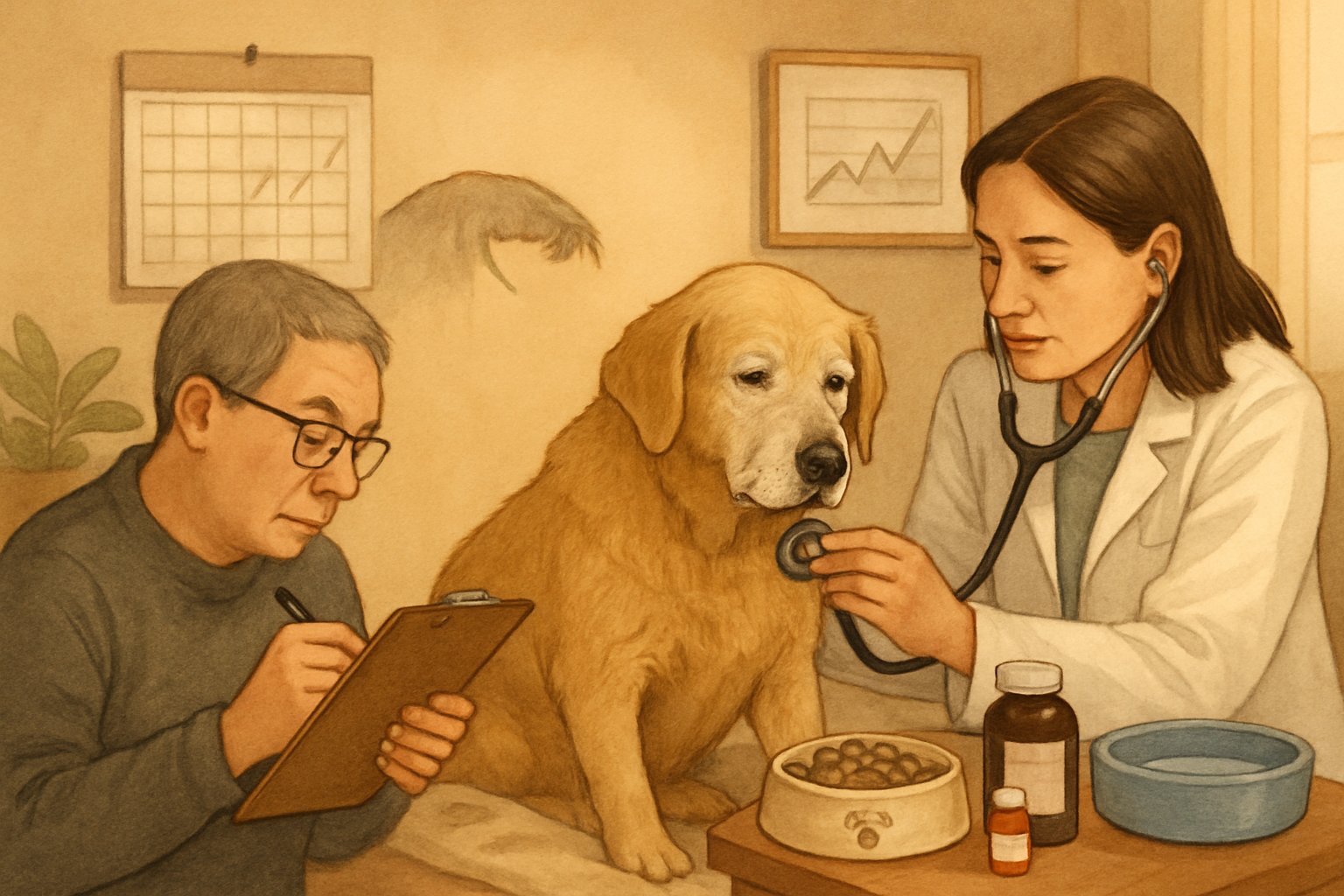
Regular vet check-ups become your best tool for tracking how your senior pet’s new diet is working. Watching them day to day at home helps you catch both wins and warning signs before they get serious.
The Importance of Regular Veterinary Check-Ups
I can’t stress enough how important those regular veterinary visits are once your pet hits their golden years. Your vet should see your furry friend at least twice a year now.
Think about it: your pet ages about 4-7 years for every human year after age 7. That’s a lot of change between check-ups.
What Your Vet Tracks During Diet Monitoring:
- Weight changes (both loss and gain matter)
- Blood work results showing kidney, liver, and thyroid function
- Body condition score to check muscle mass
- Energy levels and overall vitality
I’ve learned that senior cats especially need increased focus on oral examination, abdominal palpation, and kidney assessment. Dental issues can totally derail a good diet plan.
Your vet can catch subtle changes you might miss at home. They’ll tweak dietary recommendations based on lab results and what they see during exams.
Spotting Dietary Success—And When to Tweak the Plan
Ever wonder if that expensive senior food is actually working?
I watch for these positive signs that tell me the diet is hitting the mark:
Success Indicators:
- Improved energy for play or walks
- Shinier, softer coat texture
- Better bathroom habits (firmer stools, regular schedule)
- Maintaining healthy weight
- Less stiffness when getting up
But sometimes things go sideways, and I need to pivot quickly.
Red flags that mean it’s time to call the vet:
- Sudden appetite loss lasting more than 24 hours
- Vomiting or diarrhea within days of diet changes
- Rapid weight loss (more than 10% body weight)
- Increased water drinking and urination
- Lethargy that doesn’t improve after 2 weeks
I keep a simple daily log on my phone.
Just quick notes like “ate full breakfast, seemed peppy on walk, normal bathroom break.”
This helps me spot patterns and gives my vet real data to work with.
Most senior pets show improvement within 4-6 weeks of a proper diet change.
If I’m not seeing positive changes by then, it’s probably time to reassess with professional help.
Frequently Asked Questions
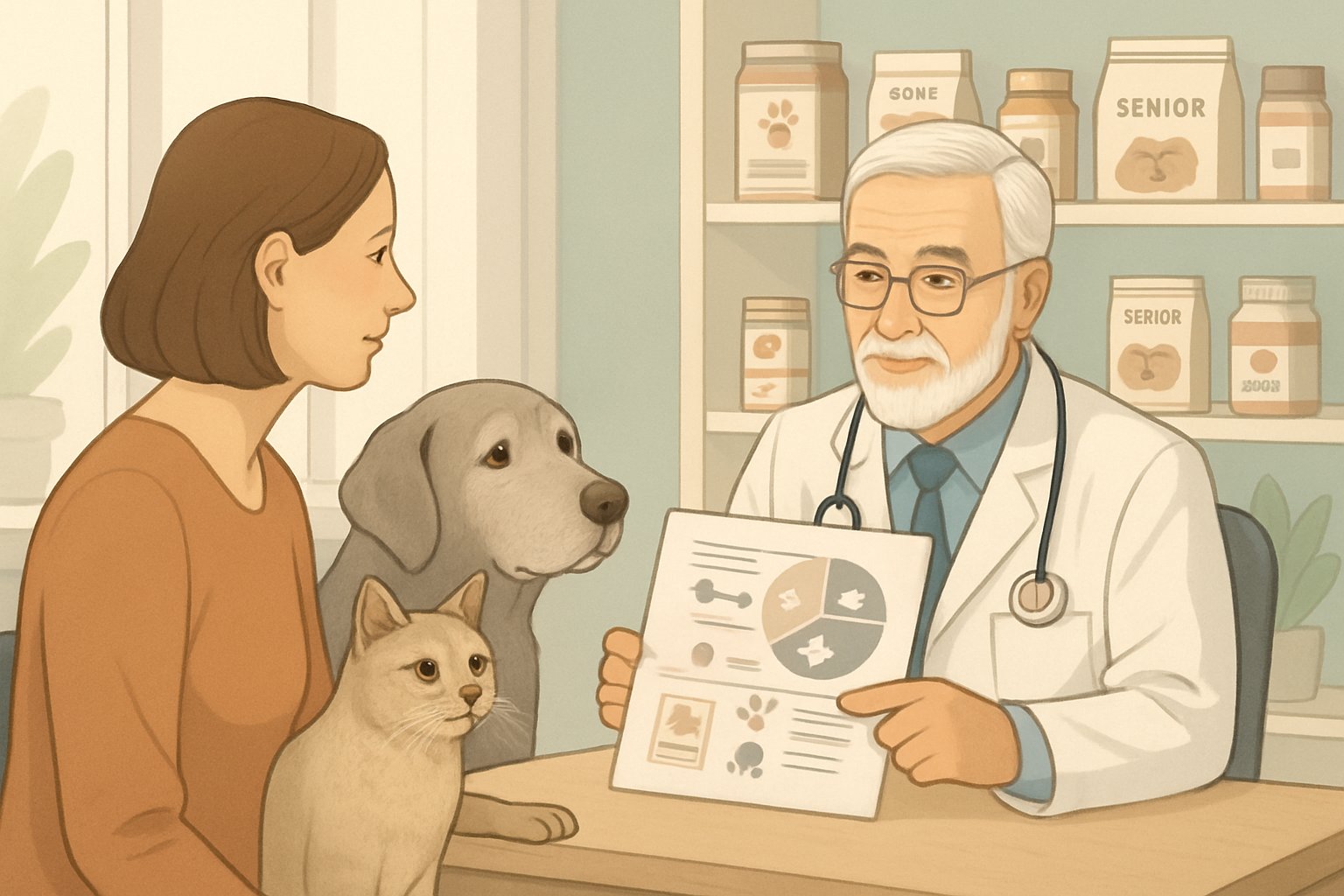
Senior dog nutrition questions pop up constantly among pet parents, and I get why.
Your aging pup’s dietary needs shift dramatically, from protein requirements to weight management challenges.
Wondering what makes a diet ideal for your golden-aged pouch?
Here’s the thing about senior dog diets—they’re not just “less calories” like many people think.
Your older dog actually needs more high-quality protein than younger adults to maintain muscle mass.
I’ve seen too many senior dogs lose muscle because their owners switched to low-protein “senior” foods.
That’s backwards thinking.
Look for these key features:
25-30% protein minimum
Easily digestible ingredients
Added omega-3 fatty acids for joint health
Controlled phosphorus for kidney support
The nutritional requirements of senior dogs differ significantly from what most commercial foods provide.
Research shows many senior diets don’t match what aging dogs actually need.
Have you noticed your senior dog isn’t as plump as they used to be? Let’s explore how to address their weight loss through nutrition.
Weight loss in senior dogs freaks me out more than weight gain.
Muscle wasting happens fast in older dogs, and once it’s gone, it’s incredibly hard to rebuild.
First, rule out medical issues.
Kidney disease, cancer, and dental problems all cause weight loss.
Don’t just add more food without knowing why your dog is losing weight.
If your vet gives the all-clear, focus on calorie-dense, high-quality foods.
Think of it like recovery nutrition for athletes.
Try these strategies:
Feed smaller, more frequent meals
Add healthy fats like fish oil
Warm the food to make it more appealing
Consider appetite stimulants if recommended by your vet
Senior pets may have changing energy requirements that require close monitoring and dietary adjustments.
Looking for tail-wag-worthy homemade recipes specifically tailored for older dogs?
I love that you want to cook for your senior dog.
Homemade meals let you control exactly what goes into their bowl.
Here’s my go-to senior dog recipe:
1 cup cooked lean ground turkey
1/2 cup cooked sweet potato
1/4 cup cooked green beans
1 tablespoon fish oil
Pinch of turmeric
Mix it all together and serve warm.
The sweet potato provides easily digestible carbs, while the turkey delivers high-quality protein.
Always consult your vet first.
Homemade diets can miss essential nutrients if not properly balanced.
I recommend working with a veterinary nutritionist to create complete recipes.
Pro tip: Batch cook and freeze portions in ice cube trays.
Perfect serving sizes that thaw quickly.
Curious about what the vet community agrees on when it comes to nourishing man’s (aging) best friend?
The veterinary community has some surprising agreements about senior dog nutrition requirements that go against popular pet food marketing.
Most vets agree on these points:
Senior dogs need more protein, not less
Weight management matters more than age-specific formulas
Regular body condition scoring is crucial
Dental health directly impacts nutrition
Here’s what surprised me: Many vets think the “senior” label on dog food is more marketing than science.
They focus more on your individual dog’s health status than their age.
The 2023 AAHA senior care guidelines emphasize that senior pets have changing nutritional needs that require individualized approaches
What’s the scoop on commercial senior dog foods? Got any winning picks from the experts?
oods disappoint me.
They’re often just adult food with less protein and more fiber.
That’s not what your aging dog needs.
Look for brands that:
List real meat as the first ingredient
Include added omega-3 fatty acids
Have controlled mineral levels
Skip unnecessary fillers like corn and wheat
Red flags I avoid:
“Senior” foods with less than 20% protein
Vague ingredient lists (“meat meal”)
Foods that rely heavily on plant proteins
Brands with recent recall histories
The reality is that senior dog diets often don’t match actual nutritional needs.
Many commercially available senior foods focus on marketing rather than science.
My approach: Find an all-life-stage food from a reputable brand and adjust portions based on your dog’s individual needs.
Got a pint-sized senior best friend? Let’s chat about the top food options for small breed elderly dogs.
Small breed senior dogs are basically metabolic hot rods. They burn through calories fast and need nutrient-dense foods in tiny packages.
Here’s what makes small breed seniors different:
They need more calories per pound.
They require smaller kibble sizes.
Dental issues pop up more often.
Skipping meals can lead to hypoglycemia.
Look for these features:
Go for small kibble size—makes sense, right?
Pick foods with high calorie density.
Easy-to-chew texture helps a lot.
Antioxidants can support their brain health.
Feeding schedule matters big time. I suggest splitting meals into 3-4 smaller portions a day instead of just two big ones.
Small dogs can run into low blood sugar if they go too long without eating.
The nutritional assessment of senior pets shows that smaller dogs often need more frequent monitoring than larger breeds.
Pro tip:
Keep some high-calorie paste or treats handy for picky eating days. Small seniors just can’t afford to skip meals.



Leave a Reply